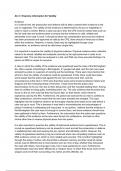Exam (elaborations)
WJEC Unit 3 Criminology AC 3.1 Examine information for Validity
- Course
- Institution
- Book
WJEC Unit 3 Criminology AC 3.1 Examine information for Validity Received an A for this exam. For personal use only, do not copy this work
[Show more]




